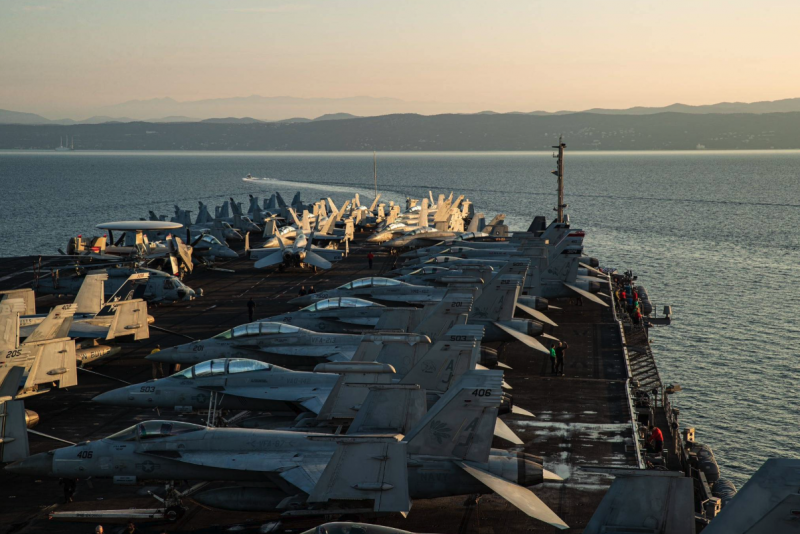
Aircraft on the USS Gerald R. Ford aircraft carrier off the Italian coast on Sept. 17, 2023. Photo from the official X account of USS Gerald R. Ford, US Navy,
Days after the Hamas offensive against Israel on October 7th, the United States announced the deployment of the USS Gerald R. Ford aircraft carrier strike group to the Eastern Mediterranean, followed by the USS Eisenhower on Oct. 14, and the USS Mount Whitney on Oct. 18.
Since then, US Defense Secretary Lloyd Austin has announced plans to further strengthen its military presence in the region, amidst growing tensions between Hezbollah and Israel in southern Lebanon, raising concerns of broader regional escalation.
The plans include deploying anti-missile defense systems, Patriot surface-to-air missile batteries and placing additional military forces on “pre-deployment” status. The exact number of US troops to be deployed, in addition to the 2,000 troops already on alert, remains unspecified.
Three objectives
According to military expert Aram Nerguizian, from the Center for International and Strategic Studies in Washington, the US Navy’s deployment of ships and equipment in the Eastern Mediterranean serves three distinct purposes.
The first is “to provide strategic support to Israel.”
The second is “to deter Hezbollah and other belligerents” .
The third is to provide “air defense or air combat patrol, if necessary. Nerguizian emphasizes that the current deployment is “not intended to be used in an offensive role.” However, he acknowledges that this could change quickly if Israel finds itself in a “total, 360-degree conflict,” although he deems this risk “unlikely” at the moment.
Regarding the “proportionality” of this American deployment in the face of the conflict between Hamas and Israel, Nerguizian believes it is an “appropriate response” to deter regional actors from expanding the conflict beyond Israel and the Gaza Strip, especially considering that the US can mobilize the resources from its allies in Cyprus, Greece and Italy.
He suggests that escalation of the conflict could include the use of anti-ship missiles, which have greater “precision and lethality” and “could lead to a wider conflict involving the Red Sea and the Gulf.”
According to Aram Nerguizian, there is currently no country in the world that can rival the military might of the US, which is capable of conducting at least two large-scale military operations in different regions. He also stresses that US forces in the Arabian Peninsula now have more flexibility and room to maneuver compared to past conflicts in Iraq and elsewhere.
What are the capabilities of the ships being sent?
- The Gerald R. Ford: the newest US aircraft carrier and the largest in the world is powered by a nuclear reactor and can accommodate over 75 military aircraft, including fighter jets. It is armed with a missile arsenal for defense against drones and planes as well as missile launchers for the defense of ships.The accompanying ships are armed with various systems, including ground-air, surface-surface and anti-submarine capabilities.
- The Dwight Eisenhower strike group is currently en route to the Eastern Mediterranean. This nuclear-powered aircraft carrier can hold up to nine squadrons of aircraft, including fighter jets, helicopters and aircraft capable of intelligence, surveillance and reconnaissance operations. Like the USS Gerald R. Ford, the USS Eisenhower travels with supporting ships for carrier defense and potential offensives.
- The USS Mount Whitney has departed from its home port in Gaeta, Italy towards the Eastern Mediterranean. Currently, its mission is solely to support American operations in the Eastern Mediterranean, as stated in the US Navy’s press release.
While the number of elements deployed in each group may appear impressive, Aram Nerguizian explains to L’Orient-Le Jour, that it follows a clear military logic. Aircraft carriers are always accompanied by support vessels for resupply, defense and deterrence, he maintains. Maritime assets such as cruisers, destroyers or nuclear attack submarines “are normally deployed as part of a carrier strike group.”
It should also be noted that the ships of Ticonderoga and Burke classes “can provide long-range strike capabilities in addition to air defense” due to their advanced combat systems. Therefore, Aram Nerguizian asserts that the current American deployment constitutes “a wide range of maritime capabilities.”
The composition of deployment:
Drawing from public announcements, and breakdowns of each American deployment, Aram Nerguizian has attempted to list the “American and allied forces currently operating in the field or heading towards the Mediterranean:”
- 2 aircraft carriers: USS Gerald R. Ford (CVN-78); USS Dwight D. Eisenhower (CVN-69)
- 1 amphibious command ship: USS Mount Whitney (LCC/JCC 20)
- 2 Ticonderoga-class cruisers: USS Normandy (CG-60); USS Philippines Sea (CG-58)
- 7 Arleigh Burke-class destroyers: USS Thomas Hudner (DDG-116); USS Ramage (DDG-61); USS Carney (DDG-64); USS Roosevelt (DDG-80); USS Laboon (DDG-58); USS Mason (DDG-87); USS Gravely (DDG-107)
- 1 Type 45 air defense destroyer: HMS Duncan (D-37)
- 5 frigates: ESPS Mendez Nunez (F-10); FS Surcouf (F-711); ITS Carlo Margottini (F-592); TCG Yavuz (F-240); HS Psara (F-454)
- 2 amphibious support ships: RFA Lyme Bay; RFA Argus
- 1 amphibious assault ship: USS Bataan (LHD-5)
- 1 amphibious dock landing ship: USS Mesa Verde (LPD-19)
- 1 dock landing ship: USS Carter Hall (LSD-50)
- An unknown number of attack submarines (SSN) of the Los Angeles and/or Virginia class